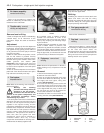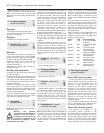
Note: Residual pressure will remain in the
fuel lines long after the vehicle was last used.
When disconnecting any fuel line, first
depressurise the fuel system as described in
Section 4.
2 Air cleaner assembly -
removal and refitting
1
Removal
1 Disconnect the inlet and outlet ducts.
2 Unscrew the mounting bolts and lift the air
cleaner from the engine.
Refitting
3 Refitting is a reversal of removal.
3 Throttle cable - removal,
refitting and adjustment
2
Removal
1 Extract the spring clip from the adjustment
ferrule located beneath the inlet manifold.
Release the cable end fitting from the linkage
the outer cable from the support bracket.
2 Working inside the car, disconnect the
cable end fitting from the top of the
accelerator pedal arm.
3 Withdraw the throttle cable through the
bulkhead grommet.
Refitting and adjustment
4 Refitting is a reversal of removal, but adjust
the cable as follows.
5 Remove the spring clip from the adjustment
ferrule then, ensuring that the throttle cam is
fully against its stop, gently pull the cable out
of its grommet until all free play is removed
from the inner cable.
6 With the cable held in this position, ensure
that the flat washer is pressed securely
against the grommet, then fit the spring clip to
the third ferrule groove visible in front of the
rubber grommet and washer.
7 Have an assistant depress the accelerator
pedal and check that the throttle cam opens
fully and returns smoothly to its stop.
4 Fuel system -
depressurisation
1
Note: Refer to the warning note in Section 1
before proceeding.
Warning: The following
procedure will merely relieve the
pressure in the fuel system -
remember that fuel will still be
present in the system components, and
take precautions accordingly before
disconnecting any of them.
1 The fuel system referred to in this Section is
defined as the tank-mounted fuel pump, the
fuel filter, the fuel injectors, the fuel rail and
the pressure regulator, and the metal pipes
and flexible hoses of the fuel lines between
these components. All these contain fuel
which will be under pressure while the engine
is running, and/or while the ignition is
switched on. The pressure will remain for
some time after the ignition has been
switched off, and must be relieved in a
controlled fashion when any of these
components are disturbed for servicing work.
2 Disconnect the battery negative lead.
3 Where possible, place a container beneath
the connection/union to be disconnected, and
have a large rag ready to soak up any
escaping fuel not being caught by the
container.
4 Slowly loosen the connection or union nut
to avoid a sudden release of pressure, and
position the rag around the connection, to
catch any fuel spray which may be expelled.
Once the pressure is released, disconnect the
fuel line. Plug the pipe ends, to minimise fuel
loss and prevent the entry of dirt into the fuel
system.
5 Fuel pump - removal and
refitting
3
Refer to Part B, Section 5.
6 Fuel gauge sender unit -
removal and refitting
3
Refer to Part A, Section 6.
7 Fuel tank - removal and
refitting
3
Refer to Part A, Section 7, noting that it will
be necessary to depressurise the fuel system
as the feed and return hoses are
disconnected from the fuel pump which is
located inside the tank. It will also be
necessary to disconnect the wiring connector
from the fuel pump before lowering the tank
out of position.
8 Unleaded petrol - general
information and usage
Note: The information given in this Chapter is
correct at the time of writing. If updated
information is thought to be required, check
with a Peugeot dealer. If travelling abroad,
consult one of the motoring organisations (or a
similar authority) for advice on the fuel
available.
1 With the exception of the XU9JA engine
(fitted to 1.9 GTI models without a catalytic
converter), all engines can be operated on 95
RON unleaded petrol. The XU9JA engine
should not be operated on 95 RON unleaded
petrol.
2 No adjustments to the ignition timing are
necessary in order to operate engines on 95
RON unleaded petrol, with the exception of
the XU5J and XU5JA engines, which must
both have the ignition timing retarded by 2°.
Refer to Chapter 5B for details of ignition
timing adjustment.
3 Do not operate an engine equipped with a
catalytic converter on leaded petrol. If a
catalytic converter is fitted, unleaded petrol
must be used at all times.
Engine Code Retard ignition by
XU5J 180A 2° (95 or 97/98 RON
unleaded)
XU5JA B6D 2° (95 or 97/98 RON
unleaded)
XU5JA/K B6E None (95 or 97/98
RON unleaded)
XU9JA/K D6B None (97/98 RON
leaded or unleaded)
XU9JA/Z DKZ None (95 or 97/98
RON unleaded)
XU9JA/L DKZ None (95 or 97/98
RON unleaded)
XU9J1/Z DFZ None (95 or 97/98
RON unleaded)
XU9J1/L DFZ None (95 or 97/98
RON unleaded)
9 Fuel injection systems -
general information
Bosch LE2-Jetronic system
A roller type electric pump located in the
fuel tank pumps fuel through the filter to the
injectors via a fuel distribution rail. The
electronic control unit (ECU) which is
triggered by the ignition circuit sends
impulses to the injectors which operate
simultaneously and inject fuel in the vicinity of
the inlet valves. The electronic control unit is
provided with sensors to determine engine
temperature, speed and load, and the
quantity of air entering the engine. This
information is computed to determine the
period of injection.
For cold starting, additional fuel is provided
and, to compensate for this, additional air is
provided by a supplementary air device.
Bosch LU2-Jetronic system
The principle of operation of the
LU2-Jetronic system is similar to that
described above for the LE2-Jetronic system,
the only significant difference is that the
LU2-Jetronic system incorporates an oxygen
sensor in the exhaust system. This enables
the ECU to carry out fine fuel mixture adjust-
ment, to allow the use of a catalytic converter.
4C•2 Fuel system - multi-point fuel injection engines


















